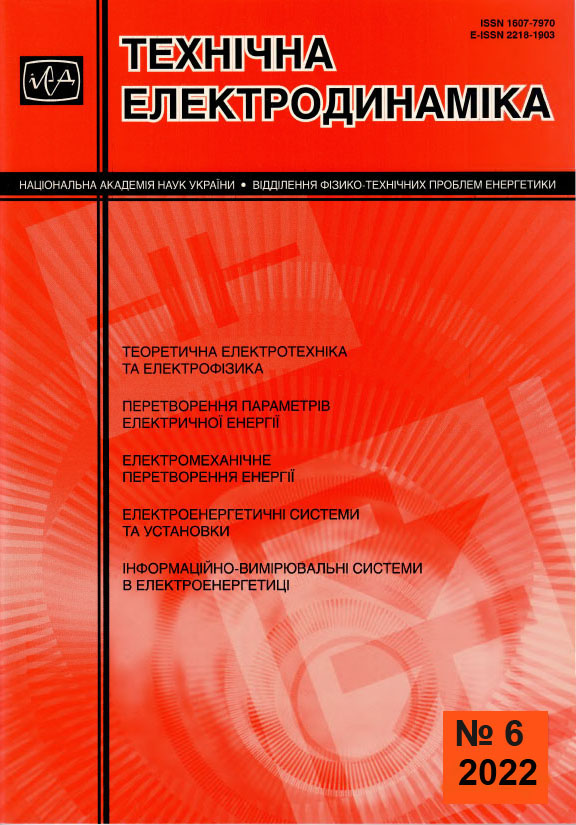Abstract
A comparative analysis of the characteristics of the salient pole synchronous machine for two variants of the rotor damping system design was performed by mathematical modeling methods. In the first embodiment, a traditional (internal) damping rotor system is used, which is made of electrically conductive rods immersed in the surface of the poles. In the second embodiment, the external damping system of the rotor is made in the form of conductive sheets fixed to the surface of the poles. It is noted that the external damping system of the rotor provides better asynchronous characteristics and is characterized by more uniform heating, which reduces the thermomechanical loads of structural elements. This design increases the reliability of the machine not only in the event of short-term asynchronous modes of operation, but also in the event of uneven air gap between the stator and rotor, which usually occurs during long operation of high-pole synchronous machines, such as hydro generators. References 10, figures 6.
References
Artyukh S.F., Urmanov O.B. Statistical analysis of electrical equipment failures at hydroelectric power stations of the Kiev HPP-PSP cascade. Bulletin of the KhPI. 2011. No 41. Pp. 3–7. (Rus)
Vaskovsky Yu.M, Tsyvinsky S.S., Titko O.I. Electromagnetic processes in the damper system of rotors of hydrogenerators with uneven air gap. Tekhnichna electrodynamika. 2015. No 1. Pp. 65–71. (Ukr)
Vaskovsky Yu.M., Geraskin O.A. Influence of mode and operational factors on the damping system of the rotor of an open-pole synchronous machine. Tekhnichna electrodynamika. 2021. No 2. Pp. 47–56. (Ukr) DOI: https://doi.org/10.15407/techned2021.02.047
Keller S., Xuan M.T., Simond J.J. Large low-speed hydro-generators – unbalanced magnetic pulls and additional damper losses in eccentricity conditions. Electric Power Appl. 2007. No 1(5). Pp. 657–664. DOI: https://doi.org/10.1049/iet-epa:20060504
Traxler-Samek G., Lugand T., Schwery A. Additional losses in damper winding of large hydrogenerators at open-circuit and load conditions. IEEE Trans on Indust. Elect. 2010. Vol. 57. No 1. Pp. 154–160. DOI: https://doi.org/10.1109/TIE.2009.2026773
Wallin M., Bladh J., Lundin U. Damper winding influence on unbalanced magnetic pull in salient pole generators with rotor eccentricity. IEEE Trans on Magnetics. 2013. Vol. 49. No 9. Pp. 5158–5165. DOI: https://doi.org/10.1109/TMAG.2013.2259633
Hongbo Qiu, Xiaobin Fan, Ran Yi, Jianqin Feng, Jie Wu, Cunxiang Yang, Haiyang Zhao/ Eddy current density asymmetric distribution of damper bars in bulb tubular turbine generator. Archives of Electrical Engineering. 2017. Vol. 66(3). Pp. 571-581. DOI: https://doi.org/10.1515/aee-2017-0043
Ehya H., Nysveen A., Nilssen R., Liu Y. Static and dynamic eccentricity fault diagnosis of large salient pole syn-chronous generators by means of external magnetic field. IET Electric Power Applications. 2021. Pp. 1–13. DOI: https://doi.org/10.1049/elp2.12068
Rahimian M., Butler-Purry K. Modeling of synchronous machines with damper windings for condition monitoring. IEEE International Electric Machines and Drives Conference. Miami, Florida, USA, 3-6 May 2009. DOI: https://doi.org/10.1109/IEMDC.2009.5075264
Titko O.I., Vaskovsky Yu.M. Synchronous-asynchronous turbogenerators. Kyiv: Naukova Dumka, 2010. 248 p. (Rus)

This work is licensed under a Creative Commons Attribution-NonCommercial-NoDerivatives 4.0 International License.
Copyright (c) 2022 Tekhnichna Elektrodynamika


